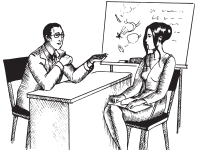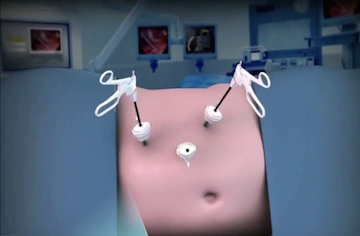Urinary Incontinence
Stress urinary incontinence is a very common condition. It’s main feature is involuntary urine loss in the presence of any increase in abdominal pressure such as coughing, laughing and sneezing sometimes even when running or jumping.
Urinary incontinence in women
What is urinary incontinence? Of course, we can give you an official definition here saying that urinary incontinence is any involuntary loss of urine. But what is behind it? Why does this seeming harmless condition affect the quality of life for so many women? Unpleasant smell, constant “dampness and discomfort”, having to use incontinence pads and fear to cough of even laugh.
What is worse, frequent urinary incontinence makes it impossible for people to leave the house because in the presence of frequent and unbearable urge to urinate the person must be sure that there is a restroom nearby. It is quite astonishing but most women consider stress urinary incontinence to be an age-related problem and are not even aware that in most cases this condition can be treated in one day.
Urinary incontinence: surgery
There are several surgical options available for urinary incontinence and all of them are capable of solving this problem in 1 day.
- First option is the placement of hyaluronic acid into the urethra and creation of a sort of “cushion”. This is an ambulatory procedure which helps in mild cases of urinary incontinence.
- So-called sling surgery for incontinence where a sling (a loop) is placed around the urethra to lift it back into a normal position and to exert pressure on the urethra to aid urine retention. All of these methods (TOT, TVT-O, Mini-secure etc.) are quite similar and are very effective. The patients are usually discharged on the day following the operation.
-Laparoscopic surgery for urinary incontinence are used in cases where urinary incontinence is accompanied by pelvic organs prolapse.
“It is impossible to cough or sneeze, I leak immediately”; “I have to change 8-10 pads a day and take a shower three times a day but the feeling that I need to wash does not go away”; “I cannot laugh and have already earned myself a reputation of a very grumpy person. But how can I laugh if I leak straight away”. “No pad seems to be able to help me doctor. I don’t know how to get rid of the smell, I feel sick.”

These are the usual complaints of women suffering from urinary incontinence. Some develop urinary incontinence after giving birth, some blame it on being overweight, some on their advancing age. It is fascinating but I hear the statement “my grandma had the same and so did my mum…. well, we are all getting all, nothing we can do here” from half of my patients. And this is coming from women who are 40-50 years old. The worst thing is that urinary incontinence makes women feel...old. Sex is out of the question all together in most cases as the woman would sooner deny herself any sort of intimate contact than allow her partner to think her hygiene measures inadequate.
Urinary incontinence in women is a thief that steal laughter, coughing and the ability to sneeze to your heart’s content.
Urinary incontinence when coughing and laughing
Urinary incontinence in women is often visible. One can see it on their face. Where does the tense and grumpy look come from? Why are their eyes damp and the words do not come out easily? It is very simple. The patient is afraid to laugh. They are afraid to cough or sneeze. Even worse, they are afraid to socialise with other people, to get close to their loved ones. Because of urinary incontinence they limit themselves and rob themselves of all of life’s little pleasures. In the past stress urinary incontinence was considered to be the problem of older women but now we often see in young women. Often it is urinary incontinence following the birth of their child.

— Good afternoon, doctor, - says the patient that appears to be in a grumpy mood. She looks about 58-60 years old, and her eyes are red as if she had been crying. – Can I come in?
— Yes, please come in, take a seat, - I get up and smile at her. Usually people smile back but not her. Some standard questions about age and some personal information. My goodness, she is only 50!
— What brought you here? What seems to be the problem?
— My grandson.
— Excuse me? — I say, thinking I might have misheard her.
— Well, yes, — the patient is struggling to fight back tears, - he is only 3 years old, I love him so much…but he does not play with me and does not let me hug him. I am losing my mind.
— But. why???
— He says I smell bad – whispers the patient and starts crying again. You see, I have urinary incontinence.
I pour her a glass of water. I want to reassure her and also want to understand how she reacts to the sound of running water, if she gets uncontrollable urges to urinate when she hears it. No, she remains sitting still, takes the glass of water gratefully and wipes her tears.
— Tell me, when did your incontinence start? And what are the conditions where you find yourself unable to contain urinary flow?
— When I sneeze, cough, laugh. I have been trying not to laugh for the past five years. Pads do not help me, no matter how often I change them the smell still remains. And I am obsessed with good hygiene.
— Why did you not go and see a doctor earlier? - I am surprised. 5 years without laughter is something you would not with on your worst enemy.
— I thought it was age related. A few of my friends have the same. They seem to manage it somehow.
Professor Z.S. Weinberg
Causes of urinary incontinence
Yes, it is indeed an age-related problem. Usually stress urinary incontinence occurs in women when levels of oestrogen, the primary female sex hormone that helps the resistance of the supporting structure of the bladder, fall. Coughing, sneezing and straining increase the pressure on the bladder and the weakened sphincter can no longer resist. At first it is not very noticeable, as it is usually only a drop, but with time the sphincter stretches further and the situation becomes worse. Urine remains in constant contact with the vagina and this causes irritation, itchiness and constant inflammation as well as making having a normal sex life difficult if not impossible...
Urinary incontinence following childbirth is a huge problem for young women. This type of incontinence is connected with the hormonal changes in the female body. During pregnancy pelvic organs are under immense pressure and pelvic floor gets overstretched. In most cases urinary incontinence after childbirth resolves itself, but sometimes the body simply does not have reserves to deal with it and restore to its normal function. Constant lifting and carrying of the child for the first year or their life may contribute to urinary incontinence after childbirth.
Another type of urinary incontinence is a so called imperative type. Unlike stress urinary incontinence, imperative urinary incontinence occurs in the presence of various bladder conditions such as interstitial cystitis, hyperactive bladder or innervation disturbance. In this case the female experiences a sudden urge to urinate and has to go to the toilet urgently. This is not always possible but she is unable to contain urine.
Urinary incontinence: Treatment
The success in treating urinary incontinence in women depends first of all on identifying the cause of urinary incontinence. Does the patient have an infection? Do they have the urge to urinate or do they not even feel urine leaking out? Is there hormonal imbalance such as diabetes or low oestrogen levels? When does urinary incontinence occur, does it happen when coughing, sneezing, physical excursion.
In approximately half the cases urinary incontinence in women can be treated without resorting to surgery. A whole spectre of non-invasive methods, physiotherapy options and medication can help completely rid the patient from this unpleasant condition.
In approximately half the cases urinary incontinence can be treated without surgery

— Can anything be done for this doctor? — Following my explanation about urinary incontinence causes my patient now has now idea how to combat it, - I simply can’t carry on like this any longer…
— There are many options and methods – I say, while I look through the reports of her urodynamic examination. There are some non -invasive methods and manipulations, there are some exercises you can you, there is surgery…Each method has its advantages and disadvantages. Non-invasive methods are aimed at restoring female sex hormones levels which in turn will strengthen tissue and improve support of the urethra, manipulations consist of an injection of a substance under the urethra which will create some volume and will now allow it to open fully and will last for about a year. There are Kegel exercises which are aimed at strengthening vaginal muscles and pelvic floor creating muscle support for the urethra at the same time. In the presence of interstitial cystitis or hyperactive bladder, which is not really your case, some medication can be used that reduce the urge to urinate as well as Botox injections into the bladder...
For cases of stress urinary incontinence, when intra-abdominal pressure increases (when coughing, sneezing or laughing) it leads to the opening of the urethral sphincter, we offer so called sling surgery. The point of this surgery id to insert a special loop (a sling) under a hypermobile area of the urethra creating some support for the urethra. The sling provides minimally traumatic and quick and long-lasting solution for urinary incontinence. VIDEO
Surgical procedures for correction of urinary incontinence are not that different from one another in terms of techniques used or even cost. There are some economy and high-end sling options available and it depends on the manufacturer’s pricing policy. We offer a wide range of slings from various manufacturers. As for the effectiveness of various types of urinary incontinence surgery for the patient there is not much difference there either.

... — Well, in your case surgery is the best option.
— Surgery?
— Yes. It is important to create some support for the urethra so it does not open during coughing. Here, look, - I draw a diagram and the end result of the surgery, - a special thin mesh is inserted under the urethra and it limits the opening ability of the urethra. This stops the incontinence.
— Will it not compress the urethra to the point that I will not be able to urinate at all? – The patient is terrified by my drawings.
— Of course not, - I smile, if we look at the name of this surgery, TVT-O — Tension free Vaginal Tape we can see that the mesh itself does not compress the urethra but provides it with support.
— How long will I have to remain in hospital? How long will it all take to heal? Will it hurt for a long time?
— 24 hours.
She doesn’t believe me. The expression on her face is akin to Stanislavsky. Not convincing.
— Hmmm, look, Vera. During this operation only one incision is made and it is only 1 cm in size. There is not enough there to hurt. There is not much to recover. And the main thing, why stay in hospital for so long?
— But what about the anaesthetic? What about coming around?
— The anaesthetic….is spinal or intravenous and only for 30 minutes. As soon as the operation is finished you will wake up. I tell her all about how safe the anaesthetic is.
— Ok, she suddenly makes a decision, what do I need to do? And when is my surgery?
— You will go through some pre-operative tests and assessment and will have a meeting with a family doctor and anaesthetist. I will operate on you towards the end of the week. Surgery will take place on Friday, I will bring you around and on Saturday you can go home. On Monday you can go back to work.
— Doctor, am I ok to at least lie down for a bit during the operation? — A big smile transforms her face.
P.S. One year later
A pleasant looking woman, no older than 40, comes into my office with a small child that looks about 4 years old. She is smiling.
— Hello doctor!
— Good afternoon, please come in and take a seat. I rub my hands with a very stinky antiseptic gel and sit down opposite her.
— Do you not recognise me, doctor? She smiles even wider. You operated on me a year ago. I look at her face trying really hard to remember. At this moment the little boy smells my hands and screwing up his face announces rather loudly: “Yuck! Smelly!”
If you suffer from urinary incontinence please book a consultation. A wide range of diagnostic tools and various treatment methods ranging from non-invasive to surgical will help free you from this condition.
If you require treatment for urinary incontinence please contact us. We will arrange your admission to hospital on the day of your arrival and will carry out all the necessary tests and if surgery is required it will be performed as soon as possible.




